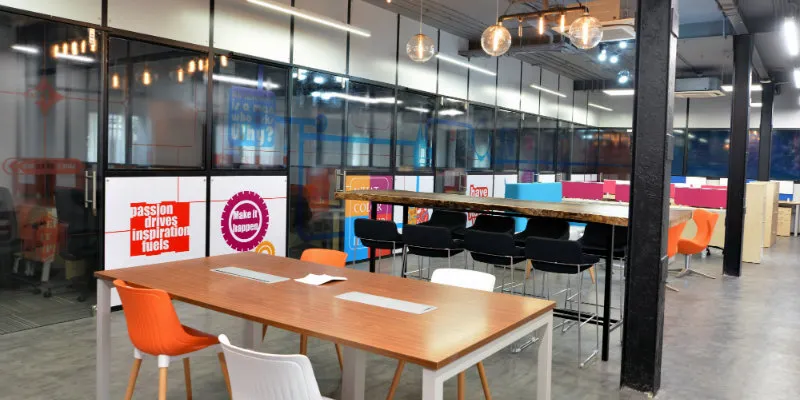Six things for startups to consider in designing an office space
Driven by favourable factors, the Indian startup ecosystem is maturing at an increasing rate. Not only have these new-age entrepreneurs reinvented the Indian economy, but also they have redefined the interior industry. Our successful home-grown startups like Myntra, InMobi, and Zomato etc have specifically designed their offices to stand-out from traditional workplaces. With approaches that do not stick to usual corporate norms and create a lasting effect, their offices are all about design and functionality to build a conducive work environment for their employees. With this in mind, designers need to have a plan in order to develop creative and efficient office spaces.

Various startups begin their journey with a small space – small or shared offices, home offices or even a garage. The increasing demand for smaller spaces to commence ventures has revolutionised the real estate market as well as leasing activities. Research by CBRE showcases that startups in 2015 leased more than 4.3 million square feet in comparison to 0.54 million in 2014. Furthermore, they highlighted that transactions involving small-sized office spaces (less than 5,000 sq. ft.) made up about 25% of the total office space transactions in 2015, compared with 19.75% in 2014. These startup offices don’t have the infrastructure of an established company, and one reason is limited resources. While an office space may be small, that doesn’t mean it has to be under-furnished or poorly designed. Designers need to be more creative and consider a contemporary approach while planning the space.
Reports say that the above-mentioned trend cannot be underestimated as the number of startups is expected to grow from 3,100 startups in 2014 to more than 11,500 by 2020. Leveraging the Internet’s power, these startups have re-engineered the way humans interact through technology. Not only have they impacted the socio-economic fabric of the nation but also altered the way Indian markets operate.
Today, Facebook’s 'Open Office' idea or Google’s branded environment designs are gaining popularity among the new-age offices. There are a number of factors that come in to play, but the discussion below highlights those that we at Vector definitely never ignore while planning or designing a workspace for new-age offices.
Culture and nature of work
An office is not just a place to work. It serves as an extension of one’s business and values. The people who work in an organisation make the company, and giving them an office that does not go with its working culture will do nothing but decrease employee morale and productivity. The energy of the organisation needs to be reflected in its interiors. Create a flexible office, and you will see a boost in employee motivation. Startups are considered ‘edgy’ – they disrupt the traditional and bring in innovation. This needs to be reflected in their offices. The workspaces need to be young, while allowing flexibility and collaboration. ‘Culture’ is another pivotal characteristic, usually associated with a lot of positivity and energy, the essence of which needs to be captured and reflected by the workspace through its design. Given the interest from various quarters, nowadays startups see rapid growth. It is important to plan an office that can manage the increasing number of employees and rapid expansion with ease.
Layout
While chalking out a layout, the designer needs to consider the shape and size of the office space, with flexibility being the key to success. With hierarchy being passé, open offices have taken the front seat as more and more companies, both startups and traditional, prefer a horizontal structure. Common spaces today are the core of any startup office. A few dedicated areas, demarcated as distraction-free zones, help during those crucial early stages of the business. Another rising practice in various companies is to opt for co-working spaces, as this helps the employees get acquainted in an environment that encourages collaboration and camaraderie. The fact that it helps people network with like-minded organisations has also resulted in the popularity of co-work offices. Apart from all the quirky and vivacious elements, a startup headquarters should also be professional space to impress the client and investors. A space where these key people can experience the company’s culture as well as understand the working pattern. While most startups do not focus on private spaces, adding a separate room for important meetings and conferences will keep the level of professionalism intact.
Furniture
Startups undergo rapid changes in terms of their furniture and space. If the workforce is mobile, then it is advisable to go for the concept of flexi-seating, which helps in getting rid of unwanted square feet. Keeping the young workforce in mind, the mantra should be to devote less space to bulky desks, and more to collaborative or breakout areas. Ergonomically correct furniture is one the best investments and suitable for any workspace. Use versatile and multipurpose furniture, as space is often an issue in startup offices.
Colours
Startups are usually a young, vibrant and innovative places to work. Colours act like an important missing piece, which, when found, can complete the puzzle. The right shade and hue can be used as a powerful element to reflect the energy of the workforce. Opt more for primary colours, graphics and art murals – they make the place vibrant and livelier. The colour on the walls should enhance the brand image of the organisation. A monotonous office is sure to drive the millennial away!
Light, ventilation and sustainable elements
Light and ventilation are often ignored while designing a space. Proper air circulation and maximum use of natural light will make the space look brighter and boost employee productivity. It has been scientifically proven that proper light and ventilation benefits our psychology, thus enhancing human performance.
Along with proper light and air circulation, going green is something that every startup should consider. With each passing day, people are becoming more conscious and aware, and this sometimes reflects in their accepting or rejecting the offer to work with a particular organisation. Installing furniture made from sustainable resources, and incorporating other design elements that help reduce carbon footprints can establish a positive image about the company amongst various stakeholders.
Value for money
Startups generally require a budget-friendly outcome. Designers need to make the most of everything that a startup office space can offer, be it office windows, grids, panes or even an unkempt corner. They have to create the perfect workspace in the most economical yet stylish way possible.
The major element while designing a startup office is comfort and elegance – when both are mixed in the correct proportions, supported by the other design elements, a perfect startup space is born.
(Disclaimer: The views and opinions expressed in this article are those of the author and do not necessarily reflect the views of YourStory.)







